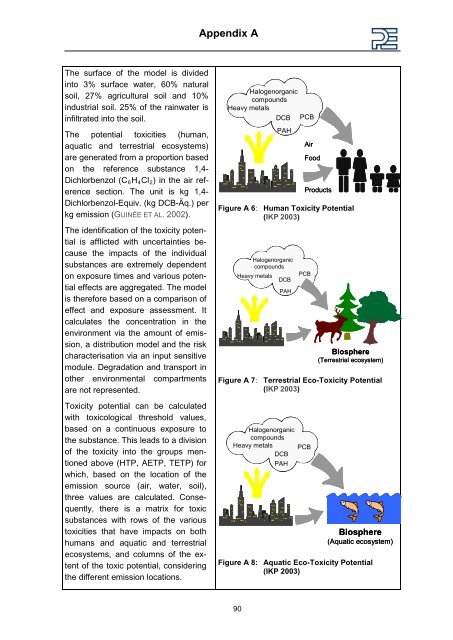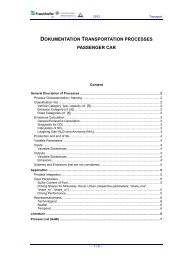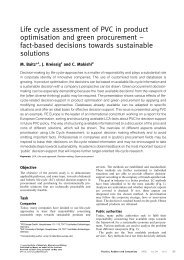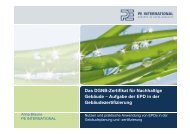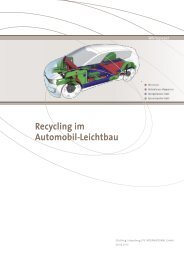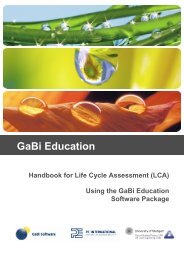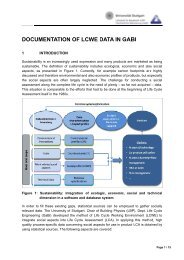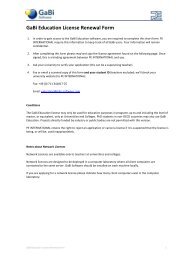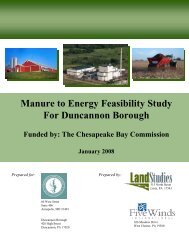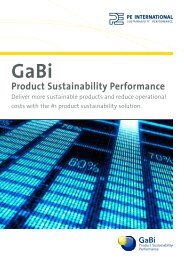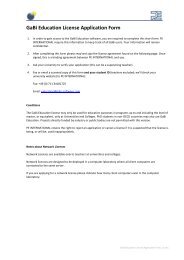Paper_Clip_Tutorial Part1.pdf - GaBi Software
Paper_Clip_Tutorial Part1.pdf - GaBi Software
Paper_Clip_Tutorial Part1.pdf - GaBi Software
You also want an ePaper? Increase the reach of your titles
YUMPU automatically turns print PDFs into web optimized ePapers that Google loves.
The surface of the model is divided<br />
into 3% surface water, 60% natural<br />
soil, 27% agricultural soil and 10%<br />
industrial soil. 25% of the rainwater is<br />
infiltrated into the soil.<br />
The potential toxicities (human,<br />
aquatic and terrestrial ecosystems)<br />
are generated from a proportion based<br />
on the reference substance 1,4-<br />
Dichlorbenzol (C6H4Cl2) in the air reference<br />
section. The unit is kg 1,4-<br />
Dichlorbenzol-Equiv. (kg DCB-Äq.) per<br />
kg emission (GUINÉE ET AL. 2002).<br />
The identification of the toxicity potential<br />
is afflicted with uncertainties because<br />
the impacts of the individual<br />
substances are extremely dependent<br />
on exposure times and various potential<br />
effects are aggregated. The model<br />
is therefore based on a comparison of<br />
effect and exposure assessment. It<br />
calculates the concentration in the<br />
environment via the amount of emission,<br />
a distribution model and the risk<br />
characterisation via an input sensitive<br />
module. Degradation and transport in<br />
other environmental compartments<br />
are not represented.<br />
Toxicity potential can be calculated<br />
with toxicological threshold values,<br />
based on a continuous exposure to<br />
the substance. This leads to a division<br />
of the toxicity into the groups mentioned<br />
above (HTP, AETP, TETP) for<br />
which, based on the location of the<br />
emission source (air, water, soil),<br />
three values are calculated. Consequently,<br />
there is a matrix for toxic<br />
substances with rows of the various<br />
toxicities that have impacts on both<br />
humans and aquatic and terrestrial<br />
ecosystems, and columns of the extent<br />
of the toxic potential, considering<br />
the different emission locations.<br />
Appendix A<br />
Halogenorganic<br />
compounds<br />
Heavy metals<br />
DCB<br />
PCB<br />
Figure A 6: Human Toxicity Potential<br />
(IKP 2003)<br />
Figure A 7: Terrestrial Eco-Toxicity Potential<br />
(IKP 2003)<br />
Figure A 8: Aquatic Eco-Toxicity Potential<br />
(IKP 2003)<br />
90<br />
PAH<br />
Halogenorganic<br />
compounds<br />
Heavy metals<br />
DCB<br />
PAH<br />
Air<br />
Food<br />
Products<br />
PCB<br />
Halogenorganic<br />
compounds<br />
Heavy metals PCB<br />
DCB<br />
PAH<br />
Biosphere<br />
(Terrestrial ecosystem)<br />
Biosphere<br />
(Aquatic ecosystem)


